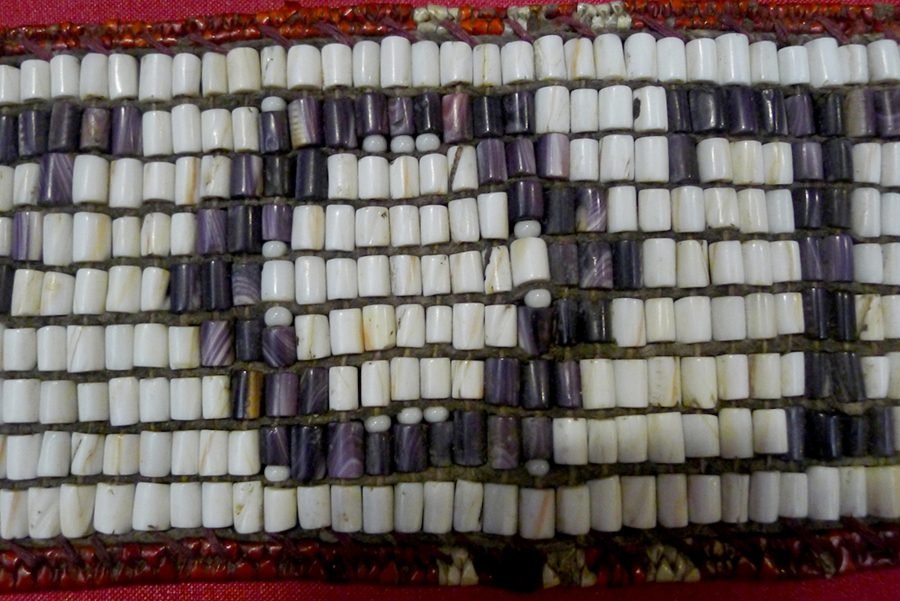Why Were Wampum Belts Important To Native Americans?
A. Sutherland - AncientPages.com - Wampum belts existed long before the European contact with the Native Americans and were used as the official tribal records, to keep historical records, to commemorate important events such as festivals or served as public records of treaties.
On one such wampum belt recorded the so-called 'Great Law of Peace', the oral constitution of the Iroquois Confederacy, a symbol of unity among the Five Nations (the Mohawk, Onondaga, Oneida, Cayuga, Seneca), which later this constitution with the sixth nation (the Tuscarora) being added about 1142.
The eastern Algonquians who lived along the coast of New England and neighboring Iroquois Indian tribe used wampum for ceremonial purposes. However, it is supposed the Iroquois were the first who started to manufacture the valuable beads for wampum.
They made the belts, strands and ribbons of beautiful, polished shells in many colors.
The belts were also valuable for communications, and as articles of exchange in form of gifts, jewelry and trade goods. Later, English and Dutch settlers began to manufacture wampum of glass beads from Europe in order to trade with the Indians and thus Wampum became an important form of money.
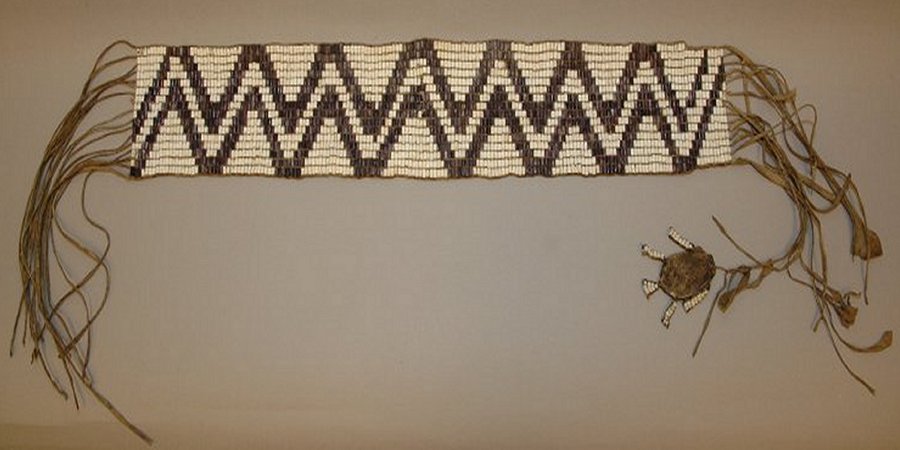
Wampum belt, with a white ground, and two parallel zig-zag lines of purple wampum, three beads in width. Most of the length of the belt is 16 beads wide; however at one end, 12 beads in from the end, the number of skin warps is reduced from 17 to 15. Image credit: British Museum
Wampum (from ‘wampumpeag’, in Algonquian, means "white strings of shell beads) were made of countless beads of white and purple seashells. This one (above) has a medicine bag attached in the form of a tortoise – the animal, which was believed to support the world.
See also:
Cedar – Sacred Tree With Medicine Power In Native American Beliefs
Native American Tradition Of A Vision Quest – How To Enter The Spiritual World
What Was The Symbolism Behind Native American Feathers?
Keepers of the Wampum were respected tribal dignitaries who stored historic strings and belts in special wooden boxes. At the great festivals, ceremonies and annual tribal meetings, the belts were brought out and stories associated with them were recited to the people who could acquaint themselves with the tribe’s history and traditions.
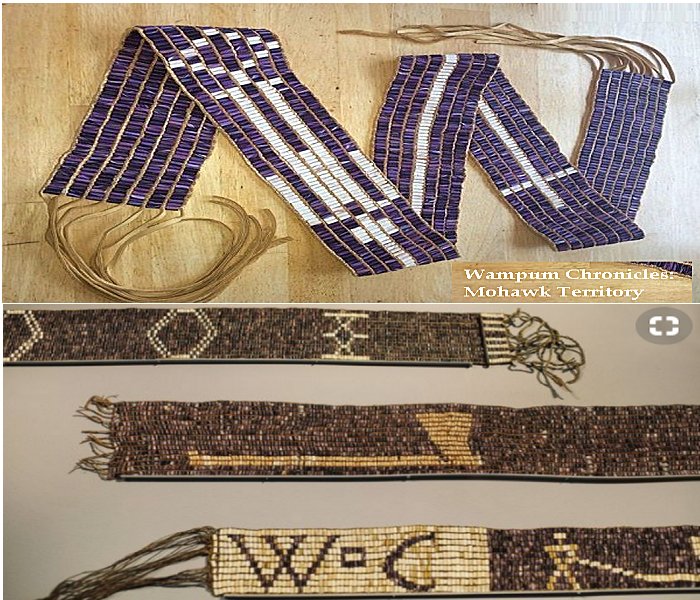
Above: The Wampum Chronicles: Mohawk Territory; Below: “Nation to Nation,” focusing on treaties, indicates a new, more historically serious direction for exhibitions at the National Museum of the American Indian.
Young men were chosen to be assistants and servants to the Keepers of the Wampum and thus they were given a special opportunity to learn the Wampum tradition.
This knowledge was important because, one day these young men would be able to take over the whole responsibility of preserving historic records of the tribe and maintaining the old custom of holding faithfully to tradition.
In addition, wampum belts played an important role during gatherings of tribal councils to demonstrate acceptance or rejection of proposed ideas. According to the tradition, a speaker ended his remarks by passing a belt across the council fire (always kept burning continually during a council of American Indians).
If one of the listeners tossed a belt aside, it meant that he rejected or doubted what the speaker said.
The oldest existing wampum belt is the Huron belt, which was given to the Jesuits commemorating the first mission house built in Huronica. It was offered and accepted in 1638, and is presently stored in the Vatican.
Written by – A. Sutherland AncientPages.com Staff Writer
Copyright © AncientPages.com All rights reserved. This material may not be published, broadcast, rewritten or redistributed in whole or part without the express written permission of AncientPages.com
Expand for referencesMore From Ancient Pages
-
 Spectacular Find: Lost Temple Of Goddess Artemis Has Been Found On Greek Island Of Euboea
Archaeology | Sep 22, 2017
Spectacular Find: Lost Temple Of Goddess Artemis Has Been Found On Greek Island Of Euboea
Archaeology | Sep 22, 2017 -
 Manticore – Legendary Persian Sphinx Whose Existence Is Still Discussed
Featured Stories | Jun 4, 2019
Manticore – Legendary Persian Sphinx Whose Existence Is Still Discussed
Featured Stories | Jun 4, 2019 -
 The Magnificent Ancient ‘Flying Airship’ Of King Solomon
Featured Stories | Aug 27, 2018
The Magnificent Ancient ‘Flying Airship’ Of King Solomon
Featured Stories | Aug 27, 2018 -
 Late Pleistocene Human Colonization – What Makes Our Species Unique Compared To Other Hominins?
Archaeology | Apr 29, 2020
Late Pleistocene Human Colonization – What Makes Our Species Unique Compared To Other Hominins?
Archaeology | Apr 29, 2020 -
 DNA Offers Insights Into The Use Of Plants By Humans In The Paleolithic Age
Archaeology | Oct 13, 2022
DNA Offers Insights Into The Use Of Plants By Humans In The Paleolithic Age
Archaeology | Oct 13, 2022 -
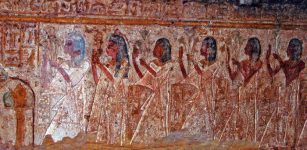 Rock-Cut Tomb Of Pennut, Viceroy Of Nubia Under Reign Of Ramses VI
Civilizations | Dec 7, 2018
Rock-Cut Tomb Of Pennut, Viceroy Of Nubia Under Reign Of Ramses VI
Civilizations | Dec 7, 2018 -
 4,000-Year-Old Tomb Altóir Na Gréine Rediscovered By Folklorist In County Kerry, Ireland
Archaeology | Jan 24, 2024
4,000-Year-Old Tomb Altóir Na Gréine Rediscovered By Folklorist In County Kerry, Ireland
Archaeology | Jan 24, 2024 -
 Unique Knife That Belonged To Early Medieval Scribe Unearthed In Poland
Archaeology | Jan 22, 2018
Unique Knife That Belonged To Early Medieval Scribe Unearthed In Poland
Archaeology | Jan 22, 2018 -
 Rare 1,600-Year-Old Wooden Pagan Idol Discovered In Ireland
Archaeology | Aug 16, 2021
Rare 1,600-Year-Old Wooden Pagan Idol Discovered In Ireland
Archaeology | Aug 16, 2021 -
 Ancient DNA Of Segorbe Giant Reveals A Brutal Event In Medieval Spain
News | Sep 26, 2021
Ancient DNA Of Segorbe Giant Reveals A Brutal Event In Medieval Spain
News | Sep 26, 2021 -
 “Thogcha” – Thousand-Year-Old Tibetan Amulets And The Bon Culture
Ancient Technology | Dec 11, 2021
“Thogcha” – Thousand-Year-Old Tibetan Amulets And The Bon Culture
Ancient Technology | Dec 11, 2021 -
 Archaeologists Uncover More Hidden Ancient Secrets In Saqqara, Egypt
Archaeology | Jan 6, 2025
Archaeologists Uncover More Hidden Ancient Secrets In Saqqara, Egypt
Archaeology | Jan 6, 2025 -
 Surprising End To Legend Of The Snallygaster That Terrorized Maryland And Washington
Featured Stories | Jun 1, 2020
Surprising End To Legend Of The Snallygaster That Terrorized Maryland And Washington
Featured Stories | Jun 1, 2020 -
 Modern Horses Have Lost Their Additional Toes, Scientists Confirm
Evolution | Jun 21, 2023
Modern Horses Have Lost Their Additional Toes, Scientists Confirm
Evolution | Jun 21, 2023 -
 Mystery Of The Anonymous God Of Palmyra Finally Solved By Scientists
Archaeology | Jun 21, 2022
Mystery Of The Anonymous God Of Palmyra Finally Solved By Scientists
Archaeology | Jun 21, 2022 -
 Vercingetorix – Visionary Nobleman And Mighty Warrior Who Led Army Of Gallic People Against The Roman Empire
Featured Stories | Feb 10, 2018
Vercingetorix – Visionary Nobleman And Mighty Warrior Who Led Army Of Gallic People Against The Roman Empire
Featured Stories | Feb 10, 2018 -
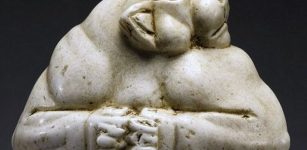 Amazing ‘Guennol Lioness’ – One Of The Greatest Ancient Works Of Art Of All Time
Artifacts | Sep 6, 2018
Amazing ‘Guennol Lioness’ – One Of The Greatest Ancient Works Of Art Of All Time
Artifacts | Sep 6, 2018 -
 Cave Hidden Under Pembroke Castle in Wales Could Hold Secrets Dating Back 10,000 Years
Archaeology | Jul 16, 2022
Cave Hidden Under Pembroke Castle in Wales Could Hold Secrets Dating Back 10,000 Years
Archaeology | Jul 16, 2022 -
 Ancient Secrets Of The Theopetra Cave: World’s Oldest Man-Made Structure And Home To Humans 130,000 Years Ago
Civilizations | May 12, 2016
Ancient Secrets Of The Theopetra Cave: World’s Oldest Man-Made Structure And Home To Humans 130,000 Years Ago
Civilizations | May 12, 2016 -
 8,000-Year-Old Human Skeletons Found In Neolithic Village Of Slatina, Bulgaria
Archaeology | Jul 30, 2020
8,000-Year-Old Human Skeletons Found In Neolithic Village Of Slatina, Bulgaria
Archaeology | Jul 30, 2020


